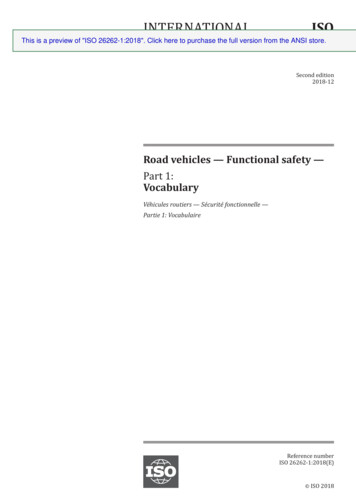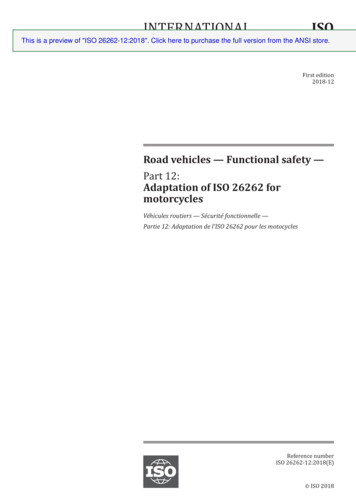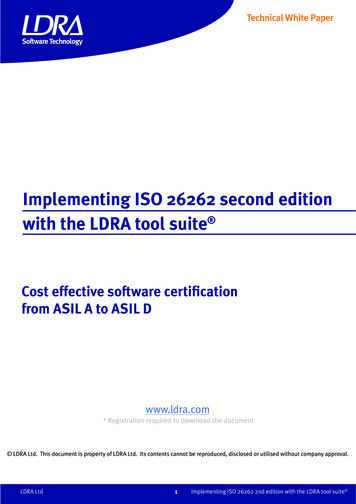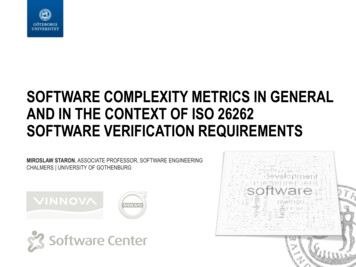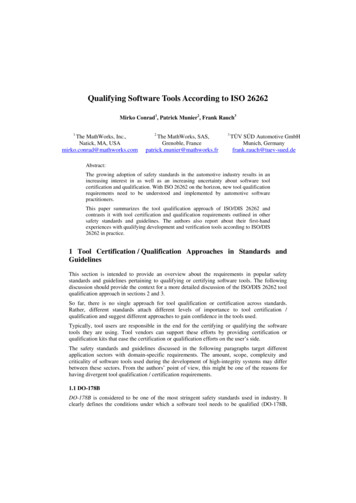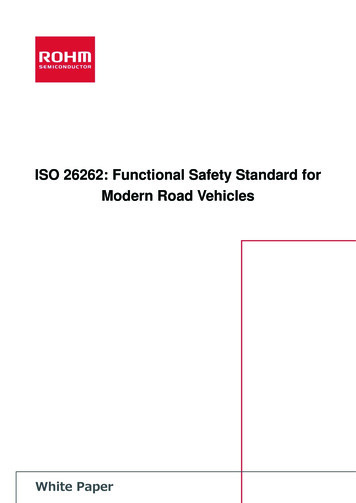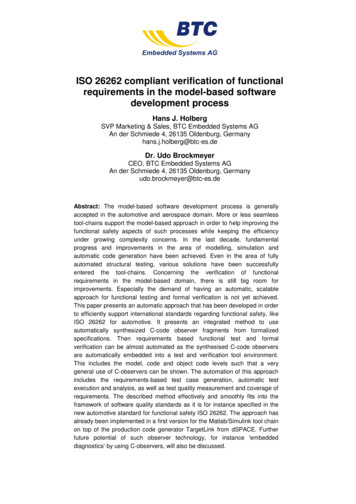
Transcription
1/15ISO 26262 – Functional Safety in Personal Vehicles: Responsibilitiesand Liabilities of Functional Safety ManagersDr. Ekkehard Helmig, Attorney-at-Law, WiesbadenPrefaceISO 26262 is a standard for the functional safety of vehicle systems which entered into force atthe end of 2011 and aims at overall functional safety in vehicles. According to concept laid outtherein, “Functional Safety Managers” (FSM) are responsible, on behalf of their company aswell as personally, for making functional electrical and/or electronic safety-related items, suchas airbags, driver assistance systems or lane departure warning systems, comply with therequirements of ISO 26262. The automotive industry deems this standard the state of the art oftechnology and engineering and considers it to be generally applicable within its sector.IIntroduction to ISO 26262The standard “Functional Safety – Road vehicles”1 takes a process-oriented2 approach tosystematize a company’s responsibilities with respect to the concept phase, development andproduction of electrical and/or electronic systems, taking into account statutory safetyregulations, the latter, however, not being specified in the standard. In its capacity as technicalstandard it also sets out legal requirements regarding the producers’ actions and thusconstitutes a classical case of law and technology overlapping. To put it into technical terms:Technical standards and legal regulations form hybrid sources to technically and legally12The extensive standard (counting more than 370 pages and only available in English) was drafted bythe International Standard Organization in close cooperation with leading vehicle manufacturers andsuppliers of safety-related systems. Even before entering into force, vehicle manufacturers had madeit an integral part of contracts for the development and manufacturing of safety-related electrical andelectronic systems. Helmig: “Fahrzeugsicherheit versus Fahrerverunsicherung – KritischeÜberlegungen zur KVV und zur ISO 26262” (Vehicle safety vs. driver insecurity. Critical thoughts ondesign responsibility agreements and ISO 26262). In: PHi, 2010, p. 194 ff.; Helmig: “Functional Safetyin accordance with ISO 26262 and product liability for No Trouble Found events”, http://www.notarhelmig.de/de/publikationen.html. (The German original was published in PHi 2012, p. 32)The term “process“ is used in a technical sense in this paper referring to the definition given byDIN EN ISO 9000:2005: “process is defined as ‘set of interrelated or interacting activities whichtransforms inputs into outputs’”. Dr. Ekkehard Helmig, Wiesbaden
2/15evaluate current safety-related systems. In this context, standards and legal regulations canonly be understood if looked at from an interdisciplinary angle. Therefore, ISO 26262 alwaysserves as complementary yardstick to construe and evaluate technical products from theviewpoint of contract law and liability law; legislation only stipulates that a product shall besafe although it does not, and cannot, regulate in detail how technical safety is to beguaranteed.3 Despite the standards’ origins in private-law organizations there is a factualnecessity to comply with them due to their importance and widespread application in practice.4II1.Although there is no absolute safety with regard to technical products5, established case-law ofthe German Federal Court of Justice (BGH) requires the manufacturer of a technical product totake all measures objectively necessary and reasonable in order to avoid danger or harm; heshall do so as early as during the concept and design phases. Required are those safetymeasures which are feasible in terms of engineering and which correspond to the state of theart of science and engineering at the time when the products are placed on the market.6The notion of what is technically possible7, coined by the BGH in this decision, refers toimplementing all technically and economically reasonable measures to guarantee maximumsafety and not to placing anything possible on the market without considering the risks. Theapplication of technology has to be measurable by legal standards.34567The rules determined by the Economic Commission for Europe (ECE) based on the “AgreementConcerning the Adoption of Uniform Technical Prescriptions for Wheeled Vehicles, Equipment andParts which can be Fitted and/or Used on Wheeled Vehicles and the Conditions for ReciprocalRecognition of Approvals Granted on the Basis of these Prescriptions”, issued on March 20, 1958, andrevised on October 16, 1995, are recommendations to the 47 member states of the Council of Europeas well as the 27 member states of the European Union that were transposed into national lawrespectively (currently about 126 rules). They are for the most part component-related. They do notconstitute general safety requirements – not to mention the problems regarding their ke: “Technologie- und technikorientiertes Unternehmensrecht”(Technology- and engineering-oriented corporate law), BB 2008, 2641.ISO 26262 (10-5.3.1) explicitly states: “Given that absolute safety is an unobtainable goal, safety casescan demonstrate that the system is free of unreasonable risk.” The standard defines the term“unreasonable risk” (1.136) as follows: “Risk judged to be unacceptable in a certain context accordingto valid societal moral concepts.”Ruling on June 16, 2009, VI ZR 107/08, VersR 2009, 1125, items 15 and 16.BGH, June 17, 2009, VI ZR 107/08, at the end of item 20 (listing further references). Dr. Ekkehard Helmig, Wiesbaden
3/152.There have been attempts in the automotive industry to make these requirements less strict byreferring to the “customs of the sector”. As a consequence thereof, technical possibilities arepraised in order to promote sales without visibly focusing on avoiding potential risks, which iswhat corresponds to the safety culture8 as required by ISO 26262. Vehicles with complexelectrical and electronic systems, manufactured by a multilayered supply chain comprisingvarious suppliers, each of whom is specialized on different fields such as airbags or driverassistance systems, are not necessarily safe, much as the individual systems might beconducive to overall vehicle safety. Following the trend of the so called connected vehicle9,where systems are operated anomalously via internet connections or infotainment systems(e.g. iphone, ipad, MP3 player) that are not vehicle-specific, particularly puts them at risk ofmalfunctioning. Malfunctions caused by influences of incompatible software which the systemcannot process or by hack attacks occur ever more frequently. 10 This so called ‘newvulnerability’ is openly discussed in the USA as well as measures which have already beenintroduced by the National Highway Traffic Safety Administration (NHTSA) to counteract thesetendencies.11 These customs of the sector, which often lag behind the technical possibilities toavoid risks, are put to an end by the BGH’s case-law. What appears perfectly logical toelectronics engineers does not necessarily have to be logical to customers.12IIIThe contents and system of ISO26262 can only be briefly described:1.ISO 26262 is targeted at achieving safety in vehicle items and hence encompasses13 the entiresafety lifecycle14 of electrical and electronic safety-related systems in vehicles as a means to891011121314ISO 26262-1:2011-1.107; ISO 26262-2:2011 – Annex B.ADAC Motorwelt, no 8, August 2012, p. 20.In its “Comprehensive Experimental Analyses of Automotive Attack Surface” the Center forAutomotive Embedded Systems Security (CAESS) has produced empirical evidence on thevulnerability of electrical systems, http://www.autosec.org/publications.html. Moreover:Handelsblatt-online on July 7, 2012: “Hacker greifen nach dem Steuer” (Hackers go for the steeringwheel).Automotive News on September 20, 2011, p. 11: “War with computer hackers hits the road”.In its issue of August 6, 2012, Automotive News featured the following comment: „Technology inautomobiles is a great thing. But what is intuitive to the electronics engineers might not be intuitiveto the customer”.ISO 26262-1:2011 -1.97According to ISO26262, the safety lifecycle encompasses the concept phase, product development,production, service and decommissioning of a safety-related system. Dr. Ekkehard Helmig, Wiesbaden
4/15avoid hazards. The safety lifecycle covers all safety activities during the concept phase, productdevelopment, production, operation, service and decommissioning.15 However, the standard isa framework and as such intended to serve as a sample for safety-related systems which mightbe based on other technologies.The standard’s introduction states that “with the trend of increasing technological complexity,software content and mechatronic implementation, there are increasing risks from systematicfailures16 and random hardware failures17.” The standard’s goal is to control this complexityand reduce residual risks, including potential hazards18 and harms19 thus arising, in order toachieve functional safety in a given system since, according to the standard, a vehicle’s safetydepends on the control systems’ reactions20 and not on the vehicle: An airbag only fulfils itsfunction within the functional safety system if its release is only triggered by collision. This wasthe case for the above mentioned decision of the German Federal Court of Justice (BGH).Currently, however, recalls due to faulty airbags occur increasingly.21ISO 26262 sets out a “concept of safety goals”22 as well as a hierarchically classified “functionalsafety concept”23 for each safety goal: (i) Hazard analyses and risk assessments identifypotential hazards, the risk of which is to be reduced; (ii) A safety goal is formulated for eachhazardous event taken into consideration; (iii) Each safety goal is assigned an AutomotiveSafety Integrity Level (ASIL)24; (iv) A functional safety concept describes a system’s functionality15161718192021222324ISO 26262-2:2011 -5.2.1ISO 26262-1:2011 -1.130ISO 26262-1:2011 -1.92ISO 26262-1:2011 -1.57ISO 26262-1:2011 -1.56; ISO 26262-1:2011 -1.59ISO 26262-1:2011 -4.1 lit. b).See: gen-airbagproblemen-3675501.html; tml; nusa-kanada--1124962.html;Chrysler alone had to recall 745.000 vehicles due to defective airbags: “Chrysler is recalling certainmodel year 2002 and 2003 Jeep Liberty vehicles manufactured January 9, 2001, through March 28,2003, and 2002 through 2004 Jeep Grand Cherokee vehicles manufactured February 13, 2001,through May 23, 2003. A component in the air bag control module may fail causing the front airbags,side curtain airbags, and/or seatbelt pretensioners to deploy inadvertently while the vehicle is beingoperated” s.cfm).Safety goals are the highest safety requirements for safety-related systems (ISO 26262-10:2012 6.5.1). They are already determined during the concept phase.ISO 26262-3:2011 -7.4.8 and 8.ISO 26262-3:2011 -7; ISO 26262-8:2011 -4.3. The standard defines five ASIL with QM-ASIL being thelowest level, followed by ASIL A, ASIL B, ASIL C and finally ASIL D as highest safety-related level. Dr. Ekkehard Helmig, Wiesbaden
5/15to achieve the safety goal; (v) A technical safety concept sets out how the functionality derivingfrom the functional safety concept is to be implemented in hardware and software; (vi) safetyrequirements for software and hardware describe those specific safety requirements which areto be part of the software and hardware design on the basis of the vehicle’s overall safetyfunctionality.All processes and measures within and between the different levels of this classification aresubject to continuous and documented confirmation measures25 with increasing significance:The confirmation review26 checks whether selected work products meet the requirements setout for a defined concept, product development or production process, either at the supplier’slevel or at supply chain level between two suppliers or ultimately at the vehicle manufacturer’slevel27. The functional safety audit evaluates the implementation of processes which arerequired for all safety activities. The functional safety assessment “evaluates the functionalsafety achieved by the item” at system level.282.What appears to be the perfect, complete and self-controlling processes of a strict regimeresulting in the assigned ASIL can lead to misunderstandings and, therefore, bears liability risks:According to the logic of ISO 26262, the functional safety of a given item does not constitute aproduct property in the sense that it will work in the vehicle. The item is only conceptually andgenerally suited to fulfill safety requirements in the vehicle if it has been designed, developedand produced according to the standard’s processes. External conditions deriving from thevehicle itself (e.g. vibration, temperature, humidity, electro-magnetic influences etc.) or trafficare expressly not taken into account.29 Therefore, functional safety is but a narrowly defineditem feature which can be evaluated according to the standard’s yardsticks by using themethods and instruments of the functional safety assessment (e.g. compatibility with othersoftware contents in the vehicle30): The airbag is to be released at the time of the crash. Thestandard does not regulate whether the airbag will actually meet this requirement, i.e. perform252627282930ISO 26262-1:2011 -1.17 and ISO 26262-2:2011 -6.ISO 26262-1:2011 -1.18Whether intermediate or final products meet specified requirements is confirmed by verificationprocesses (ISO 9000:2005 -3.8.4). Whether intermediate or final products meet the requirements ofthe next level in the supply chain is confirmed by validation (ISO 9000:2005 -3.8.5).ISO 26262-2:2011 -6.2; ISO 26262-10:2012 -5.2.2.ISO26262-2:2022 -1.So called freedom of interference. Dr. Ekkehard Helmig, Wiesbaden
6/15its function.31 Due to this self-limitation of ISO 26262 there is no equation of the kind thatfunctional safety vehicle safety.3.The evaluation of whether a hazardous event32 might occur while or due to vehicle operationas well as the evaluation of its severity33, its probability of exposure34 and the hazardousevent’s controllability 35 through the driver and/or other persons at risk (for instancepedestrians) is based on selective assumptions and assessments. These selective assumptionsare inevitably subjective and arbitrary compared to what the German Federal Court of Justice(BGH) demands. With regard to the respective safety goals for the driver’s safety theseassumptions can be correct, false or incomplete; the conclusions thus drawn about the safetymeasures, deriving from the assumptions themselves, have to be equally uncertain. Forinstance, the standard assumes the driver to be a “representative driver”, meaning he is nottired, has average driving experience in areas not exactly characterized by light traffic andcomplies with traffic rules and due care requirements regarding other traffic participants.a)The system engineer makes precise assumptions about the driver’s possible behavior in alikewise system-specific, yet arbitrary, hazardous event which are already included into theassumptions of the basic hazard analysis and the risk assessment36 during the concept phase ofa safety-related item; risk assessment is carried out to identify potential risks and define safetygoals for the specified risks respectively. Reactions due to surrounding traffic or due to a safety313233343536ISO 26262-2:2011 -6.4.5.6.ISO 26262-1:2011 -1.59ISO 26262-1:2011 -1.120ISO 26262-3:2011 -7According to ISO 26262-1:2011 1.19, controllability is “the ability to avoid a specified harm or damagethrough timely reactions of the persons involved”. It is based on the estimated probability that thedriver or other traffic participants will be capable of gaining sufficient control over the hazardousevent, such that they can avoid potential harm. (ISO 26262-10:2012 -6.3). The safety validation(ISO 26262-4:2011 -9) evaluates the assumption of controllability in the hazard analysis and the riskassessment.New issues thus arise concerning the evaluation of whether a safety-related system corresponds tostate-of-the-art science and technology as required by the BGH’s airbag decision: The evaluation,already carried out in the concept phase, of whether a product meets these requirements does notdepend on technical aspects alone. Where a product’s safety or operation largely depends on humanfactors, such as the anticipated driving behavior, these state-of-the-art-requirements can only besatisfied if an interdisciplinary approach takes into account driver psychology and findings in the fieldof accident research. Very informative: Qureshi, “A Review of Accident Modelling Approaches V86Qureshi.pdf. Dr. Ekkehard Helmig, Wiesbaden
7/15related system’s failure or malfunctioning (a damaged tire causes the tire pressure sensor tofail, which has direct impact on other engine control functions) can only be anticipated to alimited extent. The conclusions thus drawn as well as decisions based thereon regarding asafety-related item’s final design are inevitably just as inexact. Studies have shown that drivingbehavior and drivers’ attitudes towards safety-related systems differ immensely from eachother and that reliable forecasts are not possible until established safety-related systems willhave produced more empirical data.37 ISO 26262 does not set out any system or processapproach according to what German case-law stipulates, i.e. to apply the state-of-the-artrequirement regarding science, e.g. driver-related behavioral research and accident research,to state-of-the-art technology and engineering although doing so is the only way to develop acoherent safety concept.b)False assumptions and hence false conclusions regarding product realization, inevitable as theyare, have an impact on the entire safety lifecycle and cannot be completely eliminated bymeans of confirmation reviews, functional safety audits or functional assessments becauseassumptions, for instance about driving behavior, can neither be confirmed nor refuted bythese confirmation measures. A residual risk unavoidably remains to which is added furtherinevitable failure of software and hardware. A company that invokes its products’ compliancewith the technical requirements of ISO 26262 cannot claim that it places absolutely safeproducts on the market. This is why it has to call attention to residual risks. The description ofthese risks must be comprehensive, such that it enables the driver to recognize, understandand cope with them and to decide how he can avoid the risks for his own and other trafficparticipants’ sake.38IVThese weaknesses of the system cannot be avoided by ISO 26262 requiring a competencemanagement 39 , either: “The organization shall ensure that the persons involved in theexecution of the safety lifecycle have a sufficient level of skills, competences and qualificationscorresponding to their responsibilities” as well as the ability to assert their authority40. Thepersons in charge are the project manager41, the safety manager42, the person appointed to3738394041See: “Crash avoidance features reduce crashes ” (video), Highway Loss Data Institute news .BGH decision on June 16, 2009 – VI ZR 107/08, VersR 2009, 1125; Section 6 (1) of the German ProductSafety Act (ProdSG).ISO 26262-2:2011 -5.4.3.1 (Overall Safety Management).ISO 26262-2:2011 -5.4.2.1ISO 26262-2:2011 -6.4.2.2 Dr. Ekkehard Helmig, Wiesbaden
8/15carry out the functional safety audit43, the person appointed to carry out the functional safetyassessment44 as well as the person appointed “to maintain the functional safety of the itemafter its release for production”45. Together they are responsible for all safety measures takenduring development as well as any detected safety anomaly. As a consequence they have todetermine redundant communication processes which are to be applied to the entireorganization and notably fulfill the requirement of building on state-of-the-art science andengineering all the while documenting how this is achieved.46 According to the standard, thesepersons are all equally responsible. Despite gradual differences with regard to decision makingprocesses they can be called “Functional Safety Managers” (FSM).47 First and foremost, theyneed to be independent. This requirement of independence implies certain forms oforganization in a company.The company must ensure the appointed FSM’s independence, regardless of whether thisperson is an employee, a free lancer or an external consultant. This independence has to bepart of the company’s organization, needs to be documented and it must be possible to asses itin the course of management review.48 Therefore, ISO 26262 obligatorily demands that “theorganizations involved in the execution of the safety lifecycle shall have an operational qualitymanagement system complying with a quality management standard, such as ISO/TS 16949”49,ISO 9000:2008, or equivalent. ISO/TS 16949 is a generally applied standard for qualitymanagement systems (QMS) in the international automotive industry, too. It is based on theinternational standard ISO 9001:2008 and includes additional requirements specific to the4243444546474849ISO 26262-2:2011 -6.4.2.4; according to ISO 26262-2:2011 -6.4.3.1 the “safety manager shall beresponsible for the planning and coordination of the functional safety activities in the developmentphases of the safety lifecycle”.ISO 26262-2:2011 6.4.8.2ISO 26262-2:2011 -6.4.9.3ISO 26262-2:2011 -7.4.2.1ISO 26262-2:2011 -5.4.2.3ISO 26262-1:2011 1.109: According to the standard’s definition of the term, the safety manager is a“role filled by the person responsible for” the functional safety management (ISO 26262-2:2011)during the development phase.ISO/TS 16949:2009 -5.6ISO 26262-2:2011 -5.4.4.1. ISO/TS 16949:2009 is a binding Technical Specification for theinternational automotive industry; it Is based on the international standard for quality managementsystems, ISO 9001:2008, and includes additional requirements specific to the automotive industry.Both standards define the term organization as a company or facility responsible for the effectivenessof the management system so as to ensure functional safety or product quality. The termmanagement, however, differs in its meanings: While ISO/TS 16949 defines it as businessmanagement in a hierarchically structured company, ISO 26262 generically uses the term to refer tothe organization of the standard-specific processes during the safety lifecycle. Dr. Ekkehard Helmig, Wiesbaden
9/15automotive industry.50 ISO/TS 16949 is usually an integral part of contracts at all levels of theautomotive supply chain. It determines essential requirements for the company’s organization,management responsibilities, the provision of human and material resources as well as allfundamental processes during product realization.ISO 26262 and the processes therein have to be understood as processes within an effectiveQMS framework that is in compliance with ISO/TS 16949, and need to be implementedaccordingly. ISO 26262 does not name any processes which refer to, for instance, auditing thequality of parts and components of a safety-related system. Requirements of this nature gobeyond the standard’s application. They must be fulfilled by the QMS, which involves furtherrequirements with regard to the entire customer communication process, identification ofproduct-specific requirements as well as ensuring that all purchased parts and services are freefrom defects.51 When dissecting ASIL according to different safety assessments, the guaranteethat the components are free from defects is only based on the QMS.52 Hence, ISO 26262indirectly calls for an obligatory QMS, which is why QMS managers are at the same time alwaysdecision makers according to ISO 26262.1.The standard does not define the required independence of the safety managers. The “FinalDraft” (FDIS) had determined the following with respect to the confirmation measures53: “Theconfirmation measures and the associated reviewer independence requirements are appliedwithin the system safety process of an item in accordance with the highest ASIL level in thesafety goals of the item under review. In order to ensure that these evaluations are conductedin an objective manner, confirmation measures can have additional criteria for the level ofindependence of the reviewer, auditors, or assessors.” This crucial regulation has not beenincluded into Part 10 of ISO 26262 (2012) anymore. Yet, the standard still states that theindependence becomes all the more important the higher the ASIL level is.In Part 2 of the standard (“Management of functional safety”), the idea behind the FSM’sindependence can be interpreted in that it requires the FSM, who confirms that a work product,including underlying assumptions and conclusions, corresponds to its assigned safety goal, to50515253It was issued in close cooperation with the IATF (International Automotive Task Force) and sets outrequirements for quality management systems and specific requirements for the application ofISO 9001:2008 to serial and spare parts production in the automotive industry. Moreover, it iscomplemented by so called Customer Specific Requirements (CSR) of individual international vehiclemanufacturers.ISO/TS 16949 -7.4ISO 26262-10:2012 -11.3.6.2, table 4.ISO/DIS 26262-10 -5.1.3.2 „Level of independence for performing the confirmation measures“. Dr. Ekkehard Helmig, Wiesbaden
10/15not have participated in the work product’s development or conception in order to ensure themost objective evaluation possible. With regard to the hazard analysis and the risk assessment,the item’s developers, the project management and the authors of the work product are to beindependent. The same “level of independency” is required for the confirmation review of theitem integration and its testing plan, the validation plan and the safety analysis.542.From a legislative and contractual viewpoint, this normative requirement of independence haslegal quality with respect to what is required of a company’s organization as well as the FSMpersonally. This requirement is not only targeted at generating or confirming technically correctwork products based on objective evaluations. It is in particular intended to establish reliablecommunication between the parties involved in a safety-related system’s development andproduction, i.e. supplier and manufacturer, as to whether statutory and agreed safety goals arebeing met. The addressee needs to be able to trust that statements and decisions based on thisindependence are reliable, accurate and faultless; this becomes all the more importantconsidering that he will have only limited possibilities to check their being correct by carryingout verification and validation procedures if a product-specific supply chain consists of varioussuppliers. This is why ISO 26262 personifies this aspect by requiring that a person be appointedwho shall be responsible for the contractual relationship between supplier and vehiclemanufacturer.553.The FSM’s basis for decisions and his conclusions, which rely on independence, can beattributed to the company for the most part. According to ISO 26262, they represent thecompany’s entire project-related level of know-how measured against state-of-the-art scienceand technology. By confirming compliance with ISO 26262, i.e. confirming that designated andagreed safety goals are being met through safety measures which have been determined andare applied to all processes, the company defines this know-how and pretends to have it. Thisknow-how has to be documented, and thus be made an available resource, within theframework of a knowledge management which in turn is part of the overall technologymanagement.56545556ISO 26262-2:2011 -6.4.7.1, table 1. The same requirements apply to the functioncal safety audit(ISO 26262-2:2011 -6.4.8) and the functional safety assessment (ISO 26262-2:2011 -6.4.9).ISO 26262-8:2011 -5.4.2.2 lit. e)Very detailed and to the point with respect to technology management: Müller inEnsthaler/Gesmann-Nuissl/Müller: “Technikrecht: Rechtliche Grundlagen des Technologie- Dr. Ekkehard Helmig, Wiesbaden
11/15The FSM is always part of the knowledge management because he combines the company’sentire knowledge in one function with direct external impact and because he represents thisknowledge and is solely responsible for external communication about it: This applies toconfirming that contractual obligations have been fulfilled as well as to giving rise to safetyexpectations regarding the operation of a safety-related item. The term knowledge describes arather broad notion in this context: It encompasses any relevant information available to acompany during the concept phase, development and production of a safety-related system. Atthe same time it also encompasses the electronic systems’ “language” and their interaction.Communication within and between electronic components is based on flow-controlled datastreams which are capable of modeling information or objects at the level of semantics, that isthey can represent or trigger the technical processes for a safety-related system’s intendedfunctionality.57 This information consists of datasets which are generated by the item and thusposes a challenge to knowledge management as generating and transferring this information isat
5 ISO 26262 (10-5.3.1) explicitly states: Given that absolute safety is an unobtainable goal, safety cases can demonstrate that the system is free of unreasonable risk. _ The standard defines the term unreasonable risk (1.136) as follows: Risk judged to be unacceptable in a certain context according
